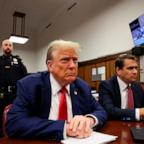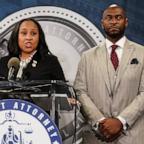In Washington, it's RG III ... or it's back to square one
— -- RICHMOND, Va. -- There's no denying it: Robert Griffin III is fighting for his job. And many around the league believe that Griffin, after consecutive poor seasons following his spectacular rookie year with the Washington Redskins, may never revive his career if he's run out of D.C.
But what about the Redskins?
Although Griffin is under enormous pressure, the stakes are even higher for this franchise, which paid a king's ransom for the QB. Success or failure can hinge on QB play in this league, and unless Griffin regains his footing, the Redskins will be back to square one.
"When I've spoken with him, he seems like he understands what he's up against, and that's important ... to be able to handle it," said former Redskins quarterback and Super Bowl hero Doug Williams, who works in the team's player-personnel department.
"He has put blinders on, and that's what he has to do, because he can't worry about what's out there, what people are saying or what they're going to say. There's nothing he can do about it. He just has to do what he's capable of doing, knowing that this is a big year for him -- which means it's a big year for all of us."
For an organization eagerly seeking encouraging signs from its most important player, the fast-approaching season couldn't be bigger.
If Griffin finally shows progress as a pocket passer, his supporters in the organization (most notably owner Daniel Snyder and team president Bruce Allen) will feel justified in the patience they've exhibited while the 2012 NFL offensive rookie of the year floundered and battled injuries. However, another awful performance by Griffin -- in 2013, he finished 24th in Total QBR at 42.2, and last season's 35.5 would have put him near the bottom of the league again if he had qualified for the rankings -- would likely lead to what seemed unthinkable after the former Heisman Trophy winner's spectacular opening act: Griffin being released before the start of the 2016 season.
That's not where the Redskins want to go, especially after trading three first-round picks and a second-rounder to the St. Louis Rams for the pick to draft Griffin. By the end of this season, the Redskins will have paid Griffin almost $25 million. The combination of that contract and the trading away of those high-round picks, which NFL teams value as much as oil companies covet mineral rights, represents a massive investment in one player.
In April, the team exercised Griffin's contract option of almost $16.2 million for 2016, which is guaranteed only for injury, and that move figures to force the issue. As much as Snyder and Allen want to justify their huge gamble, even they, presumably, wouldn't keep an unproductive player on the roster at such a high salary and cap number.
No matter what happens, Griffin's electrifying performance during his rookie season, in which he led Washington to its first NFC East division title in 13 years, probably ensures he will not be labeled as the biggest draft bust ever, but "if you only get the first contact out of him, and one playoff game, you've definitely set yourself back as a franchise because of everything you gave up," said ESPN analyst Ryan Clark, a longtime NFL safety who observed Griffin up close in his final season while starting for Washington.
"Even if you wouldn't have drafted the people the Rams drafted, and they used those picks from Washington to draft some productive people, those are picks you didn't have that could have helped you. Also, if Rob doesn't pan out, and you like your team [at other positions], you may want to try to get a franchise quarterback because you thought you had one on your roster but you really didn't. How much more is that going to cost you? And can you even get one? You would have to start all over."
NFL history tells us how a great majority of teams reach the Super Bowl: draft a quarterback capable of carrying a franchise and then build around him. Are there outliers among Lombardi Trophy winners? Absolutely. Quarterbacks weren't predominantly responsible for the success of the Chicago Bears in 1985 and Baltimore Ravens in 2000; their defenses were the stars. The conventional method, though, still offers the best blueprint. That's the one that led the Redskins to Griffin.
Snyder's 16-year tenure as owner has been marked as much by his pursuit of an elite quarterback as by the Redskins' failure on the field -- they've reached the playoffs only four times, winning two games. He figured Griffin would change all that. Clearly, though, the Redskins have revised their expectations.
After suffering a severe ankle injury and twice undergoing reconstructive knee surgery, Griffin, coaches and players say, will never again be the explosive runner who in 2012 gained 815 rushing yards on only 120 attempts. On a mix of designed runs and scrambles, Griffin rocketed to stardom, prompting opposing defensive coordinators to commit eight men to the box in an often futile attempt to contain him. That's no longer the game plan.
As long as Griffin is the starter, the Redskins' offense must take a run-first approach to make things as easy as possible for him, head coach Jay Gruden has determined. That's where Scot McCloughan comes in.
Washington's new general manager, with a track record as an excellent talent evaluator, moved quickly to support Gruden's plan, bolstering the offensive line by drafting broad-shouldered tackle Brandon Scherff, considered the top lineman in the 2015 class, and bringing in power back Matt Jones to team up with workhorse veteran Alfred Morris. The Redskins are built to run, "and when teams put eight in the box because we were running the way we could [in 2012], that's when Robert Griffin III was at his best," fullback Darrel Young said. "This is what we have to do."
So far, so good. Really.
Griffin has been sharp in camp, making strong throws and, more importantly, smart decisions as the Redskins' run-heavy offense is rolled out. It's only practice, but Griffin has completed more checkdown passes than he did all last season.
Granted, it's early, but Griffin has slowly started to inspire confidence that he could become a competent game manager. Griffin's running tab would suggest he should be much more than that -- but it is what it is.
"You can always say 'shoulda, coulda, woulda,' you just don't win games like that," veteran cornerback DeAngelo Hall said. "Obviously, we all want it to work out, but we made our decision [to draft Griffin]. Whether it works or not, we have to live with it."
Considering how much it cost the Redskins to get Griffin, you could argue their investment has already failed. But ultimately, if the Redskins decide to release Griffin, they'll pay a far greater price.



